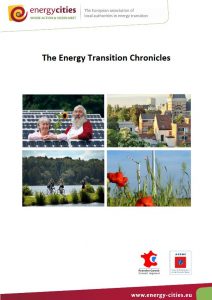In only ten years, the Brussels-Capital Region has become one of the frontrunners of sustainable construction in Europe. Thanks to an ambitious energy policy initiated in 2004, the Region has progressed from 0 m2 of passive buildings in 2007 to over 800,000 m2 in 2014. Energy use per capita has dropped by 25% and greenhouse gas emissions by 16% since 2004. As a signatory to the Convention of Mayors, the Region has set itself ambitious objectives and is committed to reducing its greenhouse gas emissions by 30% by 2025 compared to 1990.
Thanks to the experience acquired in the last decade, the Region has developed a genuine energy culture which culminated with the adoption of a passive building standard for all new buildings, public and private alike, in 2015. This new standard is the result of a joint effort by the Region and the construction industry.
In 2004, the election of a new government, more sensitive to regional energy issues, resulted in the adoption of an energy policy. A voluntary energy and environmental strategy enabled Brussels-Capital to reach a high number of professionals and private individuals, with promising first results. The Region did not, however, ignore the social dimension and the necessary protection of consumers in general and of the most vulnerable/deprived sections of the population in particular. As the main contributor to greenhouse gas emissions, the building sector became the priority target of the Region’s energy transition process. Building performance improvement was set to follow three phases: awareness, incentive and demonstration (phase 1), support and large-scale implementation (phase 2) and massive investment (phase 3).
The last phase is intended to broaden the scope of energy transition from existing buildings to the whole city so as to achieve a truly sustainable city culture.
Brussels -Capital, an attractive and cosmopolitan region
Brussels-Capital is one of the three regions that make up Belgium. Attractive and cosmopolitan, the Region was created in 1989 and comprises 19 municipalities. It benefits from stable economic growth and has many titles: capital of Flanders, capital of the French Community, capital of Belgium and capital of the EU. With 1.15 million inhabitants in 2013, Brussels-Capital concentrates around 10% of the Belgian population in an area of 161 km². With 692,442 jobs in 2011, it is the most important employment area in the country. Brussels-Capital’s GDP accounts for 19% of national GDP whereas it covers just 0.5% of national territory. Economic activities include European, federal and international administrative functions as well as financing and business services.
Its “multi-capital” status is, however, also a source of inconvenience. Only a limited number of the jobs created go to local people. Of the 3 regions, Brussels-Capital has the highest rate of unemployment, which affects 20% of the labour force, against 8.8% nationally. People under 25 and with low qualifications are the most affected. Brussels-Capital is also experiencing a phenomenon common to many conurbations, with well-to-do citizens moving to suburban areas, considered to be more pleasant. Over 50% of employees commute to the city centre every day, mostly by car, thus contributing to transferring the wealth produced in Brussels to the other two regions and thus, paradoxically, increasing poverty. The asymmetry between the amount of wealth produced and available resources generates strong disparities in terms of income, training opportunities and access to housing. This “social polarisation” has led to a territorial fracture. In some neighbourhoods, the population is getting poorer and access to housing is becoming more difficult. Most buildings are old and energy-inefficient, therefore absorbing a significant share of the residents’ income.
From a demographical point of view, Brussels-Capital is at a record high. Its population increased by 15% between 1990 and 2012 and continues to grow steadily. The population is getting younger and the birth rate is rising. According to ISBA1 forecasts, Brussels-Capital is set to pass the 1.27 million inhabitant mark by 2020.
The Brussels’ energy transition governance model
This part addresses the governance model and identifies the players, their roles and interactions in the Brussels-Capital’s energy transition process.
The energy transition process is orchestrated by the Brussels-Capital government through the Ministry of Energy, Environment and Urban Renovation and by IBGE. Like the other Belgian regions, Brussels-Capital has full powers in the fields falling within its jurisdiction as a Region, which include the environment, energy policies and employment, and in the fields of jurisdiction it transferred from the City of Brussels and the former province. The Region also cooperates with the Federal State regarding initiatives that are linked to its status as Capital of Belgium and seat of the European institutions. The Region has its own parliament and government and exercises its legislative power through enforceable ordinances. Another specific feature is the Region’s two official languages as the people of Brussels belong either to the French or Flemish community. Regional MPs are elected for five years and are divided into two lists: Frenchspeaking and Dutch-speaking. The political parties are elected by proportional representation and the governments must then form coalitions. In a nutshell, to be able to govern, a compromise with various partners (from different communities and political parties) must be reached.
The mission of IBGE is two fold: on the one hand it carries out research, plans and advises the Ministry and on the other hand, it stimulates, supervises and ensures the implementation of the political strategy.
In 2004, the Ministry and IBGE knew what they wanted to achieve: use less energy and reduce CO2 emissions. The building sector was rapidly identified as the main target as it was responsible for over 70% of end energy use and CO2 emissions. Neither the industry, which is quite limited in the region, nor mobility, which was identified as a regional planning issue rather than an energy one, were then considered to be priorities.


